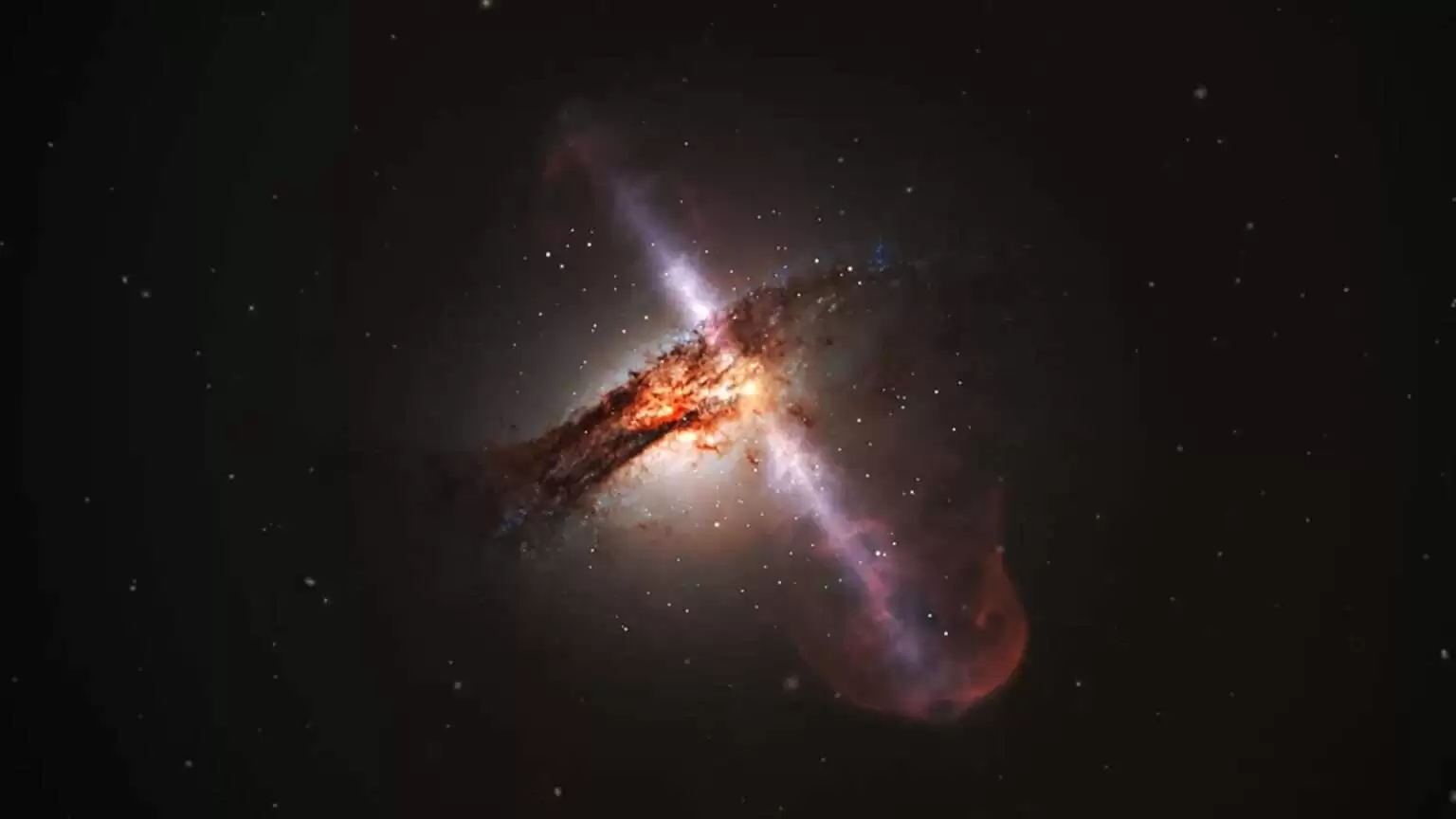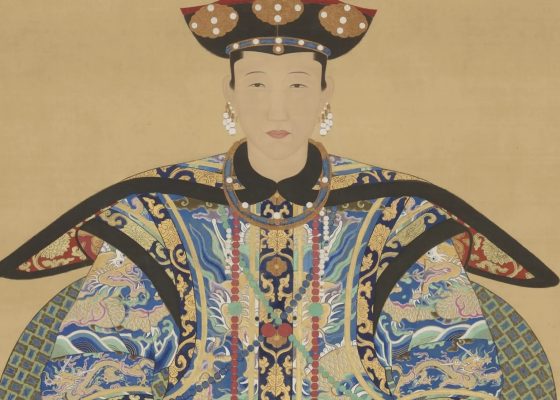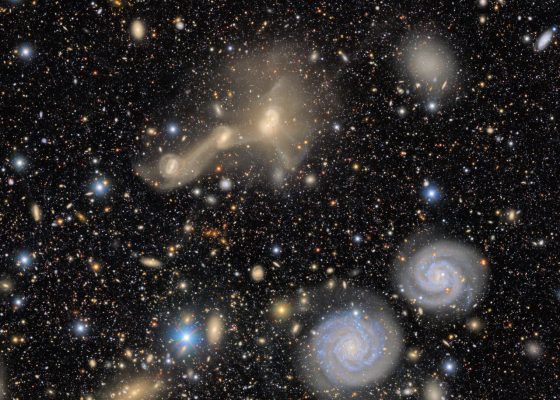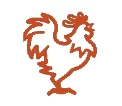
By Patchen Barss
Halfway between the belly of Delphinus the Dolphin and the hind hoof of Pegasus the flying horse, a pristine pinwheel tumbles through space. For billions of years, the flocculent spiral arms of galaxy UCG 11700 have wheeled in peace, undisturbed by the collisions and mergers that have deformed so many other galaxies.
But while a spiral galaxy like UCG 11700 is pleasing to look at, something monstrous lurks in its midst. At the heart of this beautiful cosmic Catherine wheel is one of the most mysterious objects in the Universe – a supermassive black hole.
While standard black holes start at around four times the mass of our Sun, their enormous relatives are millions, and sometimes billions, of times as massive.
Scientists believe almost every large galaxy has a supermassive black hole at its heart. Except nobody knows how they got there.
This is where galaxy UCG 11700 could prove useful.
“The ideal galaxies for my study are the most beautiful, perfect spirals you could possibly think of,” says Becky Smethurst, a junior research fellow at the University of Oxford who studies supermassive black holes. “The prettiest galaxies are the ones that could help us solve the mystery of how these black holes grow.”

Studying something that, by its nature is so dense that even light cannot escape from its centre, makes learning about it difficult. But new techniques that look for the effects supermassive black holes have on the interstellar objects around them, and even at the ripples they create in the fabric of space and time, are providing new clues.
There’s little secret about how conventional – if they can be called that – black holes form and grow. A dying star runs out of fuel, explodes in a supernova, collapses in on itself, and becomes so dense that even light cannot escape its intense gravity. The idea of black holes has been around for a century and is predicted in Albert Einstein’s Theory of General Relativity.
In popular culture, black holes are perfectly dark and endlessly hungry. They barrel through the Universe sucking up everything in their path, growing larger and more voracious as they do. Mystery solved, one might think – supermassive black holes are simply the hungriest and oldest of their kind.
In reality, however, black holes don’t live up to their monstrous reputation. They are surprisingly inefficient at accreting (physicists’ jargon for “sucking up”) surrounding material, even in a dense galactic core. In fact, collapsed stars grow so slowly, they couldn’t possibly become supermassive just by absorbing new material.
“Let’s assume the very first stars formed black holes around 200 million years after the Big Bang,” Smethurst says. “After they’ve collapsed, you’ve then got about thirteen and a half billion years to grow your black hole to billions of times the mass of the Sun. That’s too short a time to get it that big just with accretion.”
Even more mystifying, supermassive black holes already existed when the Universe was still in its relative infancy. Far-distant quasars, some of the brightest objects in the night sky, are actually ancient supermassive black holes that have set the cores of dying galaxies on fire. Some of these giants have been present at least since the Universe was a mere 670 million years old – at a time when some of the oldest known galaxies were forming.
While the heart of a black hole remains unknowable to external observers, supermassive black holes can shine more brightly than an entire galaxy of stars, and can even produce “burps” of ultraviolet radiation as they consume material around them.
If you think of anything we burn with carbon, or chemical energy, or even what happens in stars, it’s just a small, small fraction of what a black hole produces – Marta Volonteri
Black holes have a spherical boundary known as an “event horizon”. Within this sphere, light, energy, and matter are inescapably trapped. Space and time fold in on themselves, and the physical laws that describe how most of our Universe works break down. But, just outside the event horizon, a spinning black hole can whip nearby material into a spinning, superheated disc. Reaching temperatures higher than 10 million C, the accretion disc in a quasar releases blindingly bright radiation across the electromagnetic spectrum.
“Black holes are the most effective, efficient engines in the Universe,” says Marta Volonteri, a black hole researcher at l’Institut d’Astrophysique de Paris. “They transform mass into energy with up to 40% efficiency. If you think of anything we burn with carbon, or chemical energy, or even what happens in stars, it’s just a small, small fraction of what a black hole produces.”
Supermassive black holes interest scientists for more than just their energy efficiency. Their formation and evolution are clearly connected to the development of galaxies, and to the even larger story of our entire Universe’s history and structure. Solving the mystery of these cosmic giants would represent a significant step in scientists’ ongoing effort to understand why things are the way they are.
Energy release is one of many ways black holes divulge their secrets. When black holes merge or collide with slightly less dense objects like neutron stars, the events create ripples in spacetime called gravitational waves. These waves move across the cosmos at the speed of light and were first detected on Earth in 2015. Since then huge observatories like the Laser Interferometer Gravitational-wave Observatories (Ligo) in the United States, and the Virgo facility near Pisa, Italy have been picking up the ripples created by these collisions.
But while these observatories use instruments several kilometres in size, they can only detect waves from relatively modest-sized black holes.

“Ligo has detected mergers up to only about 150 solar masses,” says Nadine Neumayer, who leads the Galactic Nuclei research group at the Max Planck Institute for Astronomy. “There is a gap in data about what people call ‘intermediate-mass black holes’ of about 10,000 solar masses or so. And those actually could be the seeds for supermassive black holes.”
Intermediate-mass black holes, she says, could have formed in the very early Universe from collapsing giant gas clouds or runaway collisions of stars. In the cramped environment of the young Universe, successive collisions between these medium-sized black holes, combined with a rapid accretion of the surrounding material, could have accelerated their growth to supermassive scales.
You might also like:
The silence that delivered a solution to Einstein’s great puzzle
How weird is the space outside our solar system?
The mystery of how big our Universe really is
Still, the intermediate-mass black-hole seed theory has problems. The early, small Universe was also very hot. Gas clouds would have been bathed in radiation, possibly giving them too much energy to collapse in on themselves. And even in a dense cosmos, the laws of physics still limit the maximum rate at which black holes can absorb matter.
Volonteri says that every current explanation for supermassive black holes has “bottlenecks and drawbacks” that prevent scientists from converging on a definitive answer.
“The theories involving what we call ‘dynamical processes’, meaning you form a black hole from many, many stars rather than just one are possible, but these processes need to happen in very specific conditions,” she says. “There are also theories about ‘primordial black holes’, which could have come into existence and begun growing before there were stars. But this is completely unknown territory. We don’t have any observational proof to test this principle.”
She says she loves the physics of dynamical processes, but acknowledges that it is very difficult for the theory to credibly predict anything growing larger than about 1,000 solar masses.
“When you consider quasars that already had a billion solar masses when the Universe was a billion years old, it’s very hard to get to those numbers,” she says. She believes the true story of how supermassive black holes came to be is yet to be told. “The more we dig, the more we find there are issues with what we thought we had understood. We’re missing something fundamental.”
Most of the observable Universe’s two trillion galaxies are accelerating away from one another, but many collisions occur
The current generation of observational instruments have started to fill in the gaps. Virgo, Ligo and similar observatories are providing increasingly in-depth “demographic information” about the size, age and locations of the Universe’s black hole population.
But to fill in this kind of data on supermassive black holes, researchers are going to need even bigger detectors.
In the 2030s, Nasa and the European Space Agency (Esa) will launch the ambitious Laser Interferometer Space Antenna (Lisa), which comprises three satellites flying in a triangle with sides 2.5 million kilometres long. This array will work on similar principles to Ligo and Virgo, but its massive scale will allow it to detect gravitational waves from very large black holes beyond the reach of existing technology.
There are already hints that gravitational waves created by supermassive black holes are washing over us. At the start of 2021, astronomers announced they had detected small discrepancies in the pulses of radiation coming from 45 pulsars – compact stars that release beams of light at regular intervals. Although the results have yet to be confirmed, the researchers suggest this could be due to a “gravitational wave background” that is likely created by supermassive black hole mergers.
But there are other more direct ways of seeing black holes. The Event Horizons Telescope recently captured the first photographic images of black holes, coaxing these mysterious objects out of the shadows and revealing more about their nature and their effects of their gravity and magnetism on the galaxies they inhabit. Astrophysicists can also track the movement of stars in close orbits around black holes in the galactic core, extrapolating information about the massive objects at the centre.

Most observations of this type rely on ground-based telescopes that use a technology called “adaptive optics”. Observers analyse a bright star (or human-generated laser beam) to measure atmospheric distortions that would otherwise reduce image quality. Computer controlled signals correct for these distortions through tiny adjustments to the physical shape of the telescope’s mirror. The results are precise observations of the hearts of galaxies billions of light years away, and a wealth of data on their supermassive black holes.
Neumayer was one of the first scientists to use adaptive optics to study galactic cores.
“It was just mind-blowing that you could have better resolution from the Earth than from the Hubble Space Telescope,” she says. “I worked on measuring specific black hole masses. There is a tight correlation: the more mass a galaxy has, the more massive its central supermassive black hole is. Somehow these objects grow in step.”
Despite this correlation, there’s no clear evidence that massive galaxies create massive black holes, or vice versa. They are connected, but the nature of that connection remains a mystery.
One piece of the explanation might involve collisions between galaxies. Most of the observable Universe’s two trillion galaxies are accelerating away from one another, but many collisions occur, creating opportunities for two very large central black holes to merge into something even bigger. Some scientists believe this could be how the truly monstrous supermassive black holes are formed.
When comparatively tiny stellar black holes collide, they release huge amounts of energy for a fraction of a second, producing a flash so bright that it briefly outshines everything else in the sky. If we were to see a similar event involving supermassive black holes, it would be one of the most cataclysmic events to be detected in the night’s sky.
But, while scientists suspect mergers between supermassive black holes do occur, they may be made less common due to another problematic aspect of black hole dynamics.
Black holes on a collision course spin around one another with increasing speed as they draw closer. But very large black holes reach a point at about one parsec (3.26 light years) apart where their orbital velocity starts to balance out gravitational attraction. The decay of their orbits would happen so slowly that the actual merger could not happen within the current age of the Universe.
Astrophysicists are also exploring the possibility that supermassive black holes form directly from dark matter, the mysterious material that holds galaxies together
Nevertheless, physicists do believe such mergers happen, which requires new theories about how to overcome the so-called “final parsec problem”. Some additional force or energy is required to bring the orbiting black holes together.
The Universe is littered with galaxies that are thought to have formed through mergers, including our own Milky Way, suggesting they do occur. When galaxies do collide their original spiral structure gets destroyed as their stars, gas clouds, dark matter, and black holes interact. Even glancing blows between galaxies can mess with their structures, which makes them easy to spot.
But it means supermassive black holes at the centre of perfect pinwheel galaxies like UCG 11700 can’t be explained by collisions. Their structures suggest they have never brushed up against another galaxy.
“I pick out very rare galaxies that have been left alone their entire lives, that have been very, very isolated in the Universe,” Becky Smethurst says. “In those we can be sure that the black hole in the middle has never grown by merging with something else.”
It means they must have formed in another way.
Smethurst works backwards to determine how big these black holes would have had to have been at the beginning in order to grow to their current size. Her best models suggest a black hole that formed early in the Universe with 1,000 to 10,0000 solar masses could possibly do the trick — numbers that jibe with Neumayer’s theories about intermediate-sized “seed” black holes. But black holes of that size wouldn’t likely come from collapsing stars.

Astrophysicists are also exploring the possibility that supermassive black holes form directly from dark matter, the mysterious material that holds galaxies together. But dark matter, which is a theoretical type of particle that interacts with gravity, but is invisible to light and electromagnetism, is itself poorly understood. Combining the mysteries of black holes and dark matter only makes the physics more challenging.
“There’s still a lot we don’t know,” says Smethurst. “I think it would be arrogant of us to conclude that the only way to form a black hole is by supernova, because we don’t know that for sure. Maybe the explanation is something else entirely we just haven’t thought of yet. I am looking forward to the day the Universe surprises us with the answer. I think it will be a good day for science.”
More advanced observational instruments are on the way. This autumn, Nasa plans to launch the James Webb Space Telescope (though there is currently a push to rename the instrument due to the homophobic policies enforced by its eponymous Nasa director), whose unprecedented size and sensory capabilities will make it a valuable tool in the study of supermassive black holes. The Lisa mission, when it is launched, will also give scientists new ways of looking at supermassive black holes through their gravitational waves.
Other scientists are creating increasingly detailed maps of the locations, movements, shapes, and sizes of millions of galaxies, which feeds into the research of both observers and theoreticians.
“The pace of work is just phenomenal,” says Smethurst. “We have a hundred years’ worth of research on black holes. But compared to the 14 billion years that the Universe has been around, that’s not enough to crack all the mysteries. I set out to answer one question and end up with five more. And that’s okay with me.”
Neumayer agrees with Smethurst that the most exciting discoveries about black holes will likely relate to questions that nobody yet has asked.
“It’s been an amazing century of technical developments that make these discoveries possible,” she says. “We have a lot of known problems we want to solve. But we will also see new things we cannot even imagine. And I think that’s amazing.”
Original article from BBC





Cancel anytime


Using our website
You may use the The Middle Land website subject to the Terms and Conditions set out on this page. Visit this page regularly to check the latest Terms and Conditions. Access and use of this site constitutes your acceptance of the Terms and Conditions in-force at the time of use.
Intellectual property
Names, images and logos displayed on this site that identify The Middle Land are the intellectual property of New San Cai Inc. Copying any of this material is not permitted without prior written approval from the owner of the relevant intellectual property rights.
Requests for such approval should be directed to the competition committee.
Please provide details of your intended use of the relevant material and include your contact details including name, address, telephone number, fax number and email.
Linking policy
You do not have to ask permission to link directly to pages hosted on this website. However, we do not permit our pages to be loaded directly into frames on your website. Our pages must load into the user’s entire window.
The Middle Land is not responsible for the contents or reliability of any site to which it is hyperlinked and does not necessarily endorse the views expressed within them. Linking to or from this site should not be taken as endorsement of any kind. We cannot guarantee that these links will work all the time and have no control over the availability of the linked pages.
Submissions
All information, data, text, graphics or any other materials whatsoever uploaded or transmitted by you is your sole responsibility. This means that you are entirely responsible for all content you upload, post, email or otherwise transmit to the The Middle Land website.
Virus protection
We make every effort to check and test material at all stages of production. It is always recommended to run an anti-virus program on all material downloaded from the Internet. We cannot accept any responsibility for any loss, disruption or damage to your data or computer system, which may occur while using material derived from this website.
Disclaimer
The website is provided ‘as is’, without any representation or endorsement made, and without warranty of any kind whether express or implied.
Your use of any information or materials on this website is entirely at your own risk, for which we shall not be liable. It is your responsibility to ensure any products, services or information available through this website meet your specific requirements.
We do not warrant the operation of this site will be uninterrupted or error free, that defects will be corrected, or that this site or the server that makes it available are free of viruses or represent the full functionality, accuracy and reliability of the materials. In no event will we be liable for any loss or damage including, without limitation, loss of profits, indirect or consequential loss or damage, or any loss or damages whatsoever arising from the use, or loss of data, arising out of – or in connection with – the use of this website.
Last Updated: September 11, 2024
New San Cai Inc. (hereinafter “The Middle Land,” “we,” “us,” or “our”) owns and operates www.themiddleland.com, its affiliated websites and applications (our “Sites”), and provides related products, services, newsletters, and other offerings (together with the Sites, our “Services”) to art lovers and visitors around the world.
This Privacy Policy (the “Policy”) is intended to provide you with information on how we collect, use, and share your personal data. We process personal data from visitors of our Sites, users of our Services, readers or bloggers (collectively, “you” or “your”). Personal data is any information about you. This Policy also describes your choices regarding use, access, and correction of your personal information.
If after reading this Policy you have additional questions or would like further information, please email at middleland@protonmail.com.
PERSONAL DATA WE COLLECT AND HOW WE USE IT
We collect and process personal data only for lawful reasons, such as our legitimate business interests, your consent, or to fulfill our legal or contractual obligations.
Information You Provide to Us
Most of the information Join Talents collects is provided by you voluntarily while using our Services. We do not request highly sensitive data, such as health or medical information, racial or ethnic origin, political opinions, religious or philosophical beliefs, trade union membership, etc. and we ask that you refrain from sending us any such information.
Here are the types of personal data that you voluntarily provide to us:
As a registered users or customers, you may ask us to review or retrieve emails sent to your business. We will access these emails to provide these services for you.
We use the personal data you provide to us for the following business purposes:
Information Obtained from Third-Party Sources
We collect and publish biographical and other information about users, which we use to promote the articles and our bloggers who use our sites. If you provide personal information about others, or if others give us your information, we will only use that information for the specific reason for which it was provided.
Information We Collect by Automated Means
Log Files
The site uses your IP address to help diagnose server problems, and to administer our website. We use your IP addresses to analyze trends and gather broad demographic information for aggregate use.
Every time you access our Site, some data is temporarily stored and processed in a log file, such as your IP addresses, the browser types, the operating systems, the recalled page, or the date and time of the recall. This data is only evaluated for statistical purposes, such as to help us diagnose problems with our servers, to administer our sites, or to improve our Services.
Do Not Track
Your browser or device may include “Do Not Track” functionality. Our information collection and disclosure practices, and the choices that we provide to customers, will continue to operate as described in this Privacy Policy, whether or not a “Do Not Track” signal is received.
HOW WE SHARE YOUR INFORMATION
We may share your personal data with third parties only in the ways that are described in this Privacy Policy. We do not sell, rent, or lease your personal data to third parties, and We does not transfer your personal data to third parties for their direct marketing purposes.
We may share your personal data with third parties as follows:
There may be other instances where we share your personal data with third parties based on your consent.
HOW WE STORE AND SECURE YOUR INFORMATION
We retain your information for as long as your account is active or as needed to provide you Services. If you wish to cancel your account, please contact us middleland@protonmail.com. We will retain and use your personal data as necessary to comply with legal obligations, resolve disputes, and enforce our agreements.
All you and our data are stored in the server in the United States, we do not sales or transfer your personal data to the third party. All information you provide is stored on a secure server, and we generally accepted industry standards to protect the personal data we process both during transmission and once received.
YOUR RIGHTS/OPT OUT
You may correct, update, amend, delete/remove, or deactivate your account and personal data by making the change on your Blog on www.themiddleland.com or by emailing middleland@protonmail.com. We will respond to your request within a reasonable timeframe.
You may choose to stop receiving Join Talents newsletters or marketing emails at any time by following the unsubscribe instructions included in those communications, or you can email us at middleland@protonmail.com
LINKS TO OTHER WEBSITES
The Middle Land include links to other websites whose privacy practices may differ from that of ours. If you submit personal data to any of those sites, your information is governed by their privacy statements. We encourage you to carefully read the Privacy Policy of any website you visit.
NOTE TO PARENTS OR GUARDIANS
Our Services are not intended for use by children, and we do not knowingly or intentionally solicit data from or market to children under the age of 18. We reserve the right to delete the child’s information and the child’s registration on the Sites.
PRIVACY POLICY CHANGES
We may update this Privacy Policy to reflect changes to our personal data processing practices. If any material changes are made, we will notify you on the Sites prior to the change becoming effective. You are encouraged to periodically review this Policy.
HOW TO CONTACT US
If you have any questions about our Privacy Policy, please email middleland@protonmail.com
The Michelin brothers created the guide, which included information like maps, car mechanics listings, hotels and petrol stations across France to spur demand.
The guide began to award stars to fine dining restaurants in 1926.
At first, they offered just one star, the concept was expanded in 1931 to include one, two and three stars. One star establishments represent a “very good restaurant in its category”. Two honour “excellent cooking, worth a detour” and three reward “exceptional cuisine, worth a
Thank you for your participation,
please Log in or Sign up to Vote

123Sign in to your account